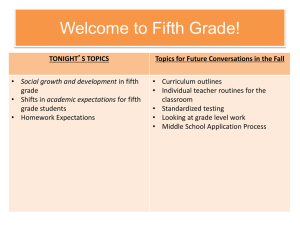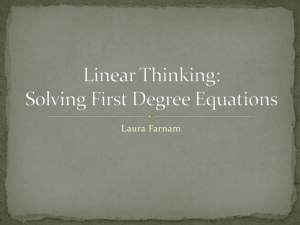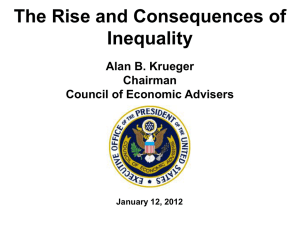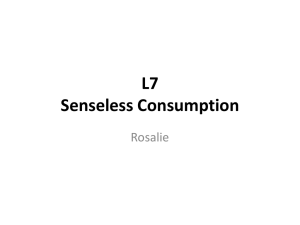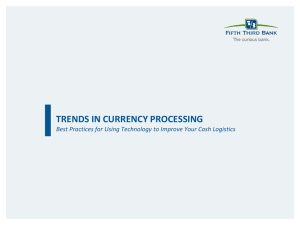Chapter 7
advertisement
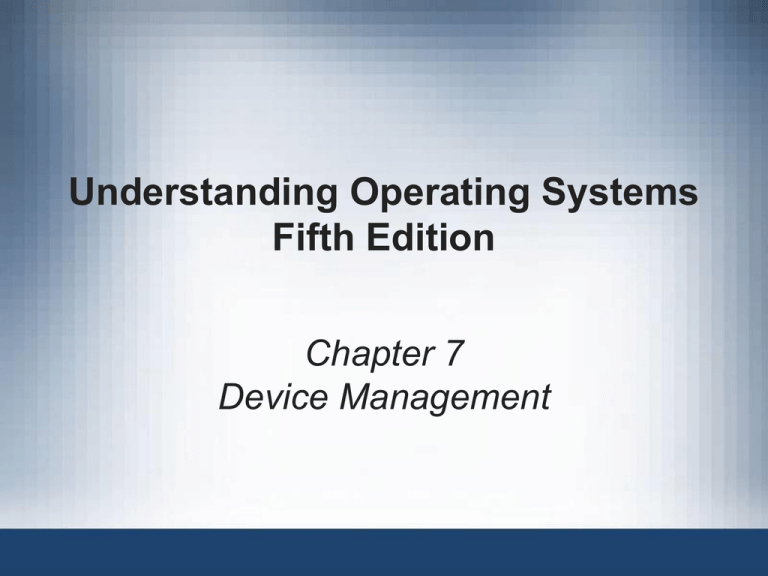
Understanding Operating Systems Fifth Edition Chapter 7 Device Management Learning Objectives • Features of dedicated, shared, and virtual devices • Differences between sequential and direct access media • Concepts of blocking and buffering and how they improve I/O performance • Roles of seek time, search time, and transfer time in calculating access time • Differences in access times in several types of devices Understanding Operating Systems, Fifth Edition 2 Learning Objectives (continued) • Critical components of the input/output subsystem, and how they interact • Strengths and weaknesses of common seek strategies, including FCFS, SSTF, SCAN/LOOK, C-SCAN/C-LOOK, and how they compare • Different levels of RAID and what sets each apart from the others Understanding Operating Systems, Fifth Edition 3 Types of Devices • Dedicated Devices • Device assigned to one job at a time – For entire time job is active (or until released) – Example: tape drives, printers, and plotters • Disadvantage – Inefficient if device is not used 100% – Allocated for duration of job’s execution Understanding Operating Systems, Fifth Edition 4 Types of Devices (continued) • Shared Devices • Device assigned to several processes – Example: direct access storage device (DASD) • Processes share DASD simultaneously • Requests interleaved • Device manager supervision – Controls interleaving • Predetermined policies determine conflict resolution Understanding Operating Systems, Fifth Edition 5 Types of Devices (continued) • Virtual Devices • Dedicated and shared device combination • Dedicated devices transformed into shared devices – Example: printer • Converted by spooling program • Spooling – Speeds up slow dedicated I/O devices – Example: universal serial bus (USB) controller • Interface between operating system, device drivers, applications, and devices attached via USB host Understanding Operating Systems, Fifth Edition 6 Types of Devices (continued) • Storage media • Two groups – Sequential access media • Records stored sequentially – Direct access storage devices (DASD) • Records stored sequentially • Records stored using direct access files • Vast differences – Speed and sharability Understanding Operating Systems, Fifth Edition 7 Sequential Access Storage Media • • • • Magnetic tape Early computer systems: routine secondary storage Today’s use: routine archiving and data backup Records stored serially – Record length determined by application program – Record identified by position on tape – Record access • Tape mount • Fast-forwarded to record – Time-consuming process Understanding Operating Systems, Fifth Edition 8 Sequential Access Storage Media (continued) • Tape density: characters recorded per inch – Depends upon storage method (individual or blocked) • Tape reading/writing mechanics – Tape moves under read/write head when needed Understanding Operating Systems, Fifth Edition 9 Sequential Access Storage Media (continued) • Interrecord gap (IRG) – ½ inch gap inserted between each record – Same size regardless of records it separates • Blocking: group records into blocks • Transfer rate: (tape density) x (transport speed) • Interblock gap (IBG) – ½ inch gap inserted between each block – More efficient than individual records and IRG Understanding Operating Systems, Fifth Edition 10 Sequential Access Storage Media (continued) Understanding Operating Systems, Fifth Edition 11 Sequential Access Storage Media (continued) • Blocking advantages – Fewer I/O operations needed – Less wasted tape • Blocking disadvantages – Overhead and software routines needed for blocking, deblocking, and record keeping – Buffer space wasted • When only one logical record needed Understanding Operating Systems, Fifth Edition 12 Sequential Access Storage Media (continued) • Advantages – Low cost, compact storage capabilities, good for magnetic disk backup and long-term archival • Disadvantages – Access time • Poor for routine secondary storage – Poor for interactive applications Understanding Operating Systems, Fifth Edition 13 Direct Access Storage Devices • Directly read or write to specific disk area – Random access storage devices • Four categories – – – – Magnetic disks Optical discs Flash memory Magneto-optical disks • Access time variance – Not as wide as magnetic tape – Record location directly affects access time Understanding Operating Systems, Fifth Edition 14 Fixed-Head Magnetic Disk Storage • Looks like a large CD or DVD – Covered with magnetic film – Formatted • Both sides (usually) in concentric circles called tracks – Data recorded serially on each track • Fixed read/write head positioned over data • Advantages – Fast (more so than movable head) • Disadvantages – High cost and reduced storage Understanding Operating Systems, Fifth Edition 15 Fixed-Head Magnetic Disk Storage (continued) Understanding Operating Systems, Fifth Edition 16 Movable-Head Magnetic Disk Storage • One read/write head floats over disk surface – Example: computer hard drive – Disks • Single platter • Part of disk pack (stack of platters) • Disk pack platter – Two recording surfaces • Exception: top and bottom platters – Surface formatted with concentric tracks – Track number varies • 100 (floppy disk) to 1000+ (high-capacity disk) Understanding Operating Systems, Fifth Edition 17 Movable-Head Magnetic Disk Storage (continued) • Disk pack platter (continued) – Track surface number • Track zero: outermost concentric circle on each surface • Center: contains highest-numbered track – Arm moves over all heads in unison • Slower: fill disk pack surface-by-surface • Faster: fill disk pack track-by-track – Virtual cylinder: fill track zero • Record access system requirements – Cylinder number, surface number, record number Understanding Operating Systems, Fifth Edition 18 Movable-Head Magnetic Disk Storage (continued) Understanding Operating Systems, Fifth Edition 19 Optical Disc Storage • Design difference – Magnetic disk • Concentric tracks of sectors • Spins at constant angular velocity (CAV) • Wastes storage space but fast data retrieval Understanding Operating Systems, Fifth Edition 20 Optical Disc Storage (continued) • Design features – Optical disc • Single spiralling track of same-sized sectors running from center to disc rim • Spins at constant linear velocity (CLV) • More sectors and more disc data Understanding Operating Systems, Fifth Edition 21 Optical Disc Storage (continued) • Two important performance measures – Sustained data-transfer rate • Speed to read massive data amounts from disc • Measured in megabytes per second (Mbps) • Crucial for applications requiring sequential access – Average access time • Average time to move head to specific disc location • Expressed in milliseconds (ms) • Third feature – Cache size (hardware) • Buffer to transfer data blocks from disc Understanding Operating Systems, Fifth Edition 22 Optical Disc Storage (continued) • CD-ROM technology (CD read-only memory) – Similar to audio CD • CD-ROM is sturdier with rigorous error correction – Data recorded as zeros and ones • Pits: indentations • Lands: flat areas – Reads with low-power laser • Light strikes land and reflects to photodetector • Pit is scattered and absorbed • Photodetector converts light intensity into digital signal – Various speed classifications (32X, 48X, 75X) • How fast drive spins Understanding Operating Systems, Fifth Edition 23 Optical Disc Storage (continued) • CD-Recordable technology (CD-R) – – – – Requires expensive disk controller Records data using write-once technique Data cannot be erased or modified Disk • • • • • Contains several layers Gold reflective layer and dye layer Records with high-power laser Permanent marks on dye layer CD cannot be erased after data recorded – Data read on standard CD drive (low-power beam) Understanding Operating Systems, Fifth Edition 24 Optical Disc Storage (continued) • CD-Rewritable technology (CD-RW) – Data written, changed, erased – Uses phase change technology • Amorphous and crystalline phase states – Record data: beam heats up disc • State changes from crystalline to amorphous – Erase data: low-energy beam to heat up pits • Loosens alloy to return to original crystalline state – Drives read standard CD-ROM, CD-R, CD-RW discs – Drives store large quantities of data, sound, graphics, multimedia Understanding Operating Systems, Fifth Edition 25 Optical Disc Storage (continued) • DVD technology (Digital Versatile Disc) • CD-ROM comparison – Similar in design, shape, size – Differs in data capacity • Dual-layer, single-sided DVD holds 13 CDs • Single-layer, single-sided DVD holds 8.6 GB (MPEG video compression) – Differs in laser wavelength • Uses red laser (smaller pits, tighter spiral) • DVDs cannot be read by CD or CD-ROM drives • DVD-R and DVD-RW provide rewritable flexibility Understanding Operating Systems, Fifth Edition 26 Magneto-Optical Storage • Combines magnetic and optical disk technology • Magnetic disk comparison – Reads and writes similarly – Magneto-optical (MO) disks store several GB – Access rate • Faster than floppy • Slower than hard drive – Hardier than optical discs Understanding Operating Systems, Fifth Edition 27 Magneto-Optical Storage (continued) • Read/write process – Read • Laser beam polarizes light by crystals in alloy • Reflected to photodiode and interpreted – Write • Uses narrow laser beam and crystal polarization • No permanent physical change • Changes made many times • Repeated writing – No medium deterioration (occurs with optical discs) Understanding Operating Systems, Fifth Edition 28 Flash Memory Storage • Electronically erasable programmable read-only memory (EEP) – Nonvolatile and removable – Emulates random access • Difference: data stored securely (even if removed) • Data stored on microchip card or “key” – Compact flash, smart cards, memory sticks – Often connected through USB port • Write data: electric charge sent through floating gate • Erase data: strong electrical field (flash) applied Understanding Operating Systems, Fifth Edition 29 DASD Access Times • File access time factors – Seek time (slowest) • Time to position read/write head on track • Does not apply to fixed read/write head devices – Search time • Rotational delay • Time to rotate DASD • Rotate until desired record under read/write head – Transfer time (fastest) • Time to transfer data • Secondary storage to main memory transfer Understanding Operating Systems, Fifth Edition 30 Fixed-Head Devices • Record access requires two items – Track number and record number • Access time = search time + transfer time • Total access time – Rotational speed dependent • DASDs rotate continuously – Three basic positions for requested record • In relation to read/write head position • DASD has little access variance – Good candidates: low activity files, random access • Blocking used to minimize access time Understanding Operating Systems, Fifth Edition 31 Fixed-Head Devices (continued) Understanding Operating Systems, Fifth Edition 32 Movable-Head Devices (continued) • Record access requires three items – Seek time + search time + transfer time • Search time and transfer time calculation – Same as fixed-head DASD • Blocking is a good way to minimize access time Understanding Operating Systems, Fifth Edition 33 Components of the I/O Subsystem • I/O Channel • Programmable units – Positioned between CPU and control unit • Synchronizes device speeds – CPU (fast) with I/O device (slow) • Manages concurrent processing – CPU and I/O device requests • Allows overlap – CPU and I/O operations • Channels: expensive because so often shared Understanding Operating Systems, Fifth Edition 34 Components of the I/O Subsystem (continued) • I/O channel programs – Specifies action performed by devices – Controls data transmission • Between main memory and control units • I/O control unit: receives and interprets signal • Disk controller (disk drive interface) – Links disk drive and system bus • Entire path must be available when I/O command initiated • I/O subsystem configuration – Multiple paths increase flexibility and reliability Understanding Operating Systems, Fifth Edition 35 Components of the I/O Subsystem (continued) Understanding Operating Systems, Fifth Edition 36 Components of the I/O Subsystem (continued) Understanding Operating Systems, Fifth Edition 37 Communication Among Devices • Problems to resolve – Know which components are busy/free • Solved by structuring interaction between units – Accommodate requests during heavy I/O traffic • Handled by buffering records and queuing requests – Accommodate speed disparity between CPU and I/O devices • Handled by buffering records and queuing requests Understanding Operating Systems, Fifth Edition 38 Communication Among Devices (continued) • I/O subsystem units finish independently of others • CPU processes data while I/O performed • Success requires device completion knowledge – Hardware flag tested by CPU • Channel status word (CSW) contains flag • Three bits in flag represent I/O system component (channel, control unit, device) • Changes zero to one (free to busy) – Flag tested using polling and interrupts • Interrupts are more efficient way to test flag Understanding Operating Systems, Fifth Edition 39 Communication Among Devices (continued) • Direct memory access (DMA) – Allows control unit main memory access directly – Transfers data without the intervention of CPU – Used for high-speed devices (disk) • Buffers – Temporary storage areas in main memory, channels, control units – Improves data movement synchronization • Between relatively slow I/O devices and very fast CPU – Double buffering: processing of record by CPU while another is read or written by channel Understanding Operating Systems, Fifth Edition 40 Communication Among Devices (continued) Understanding Operating Systems, Fifth Edition 41 Management of I/O Requests • I/O traffic controller – Watches status of devices, control units, channels – Three main tasks • Determine if path available • If more than one path available, determine which one to select • If paths all busy, determine when one is available – Maintain database containing unit status and connections Understanding Operating Systems, Fifth Edition 42 Management of I/O Requests (continued) • I/O scheduler – Same job as process scheduler (Chapter 4) – Allocates devices, control units, channels – If requests greater than available paths • Decides which request to satisfy first: based on different criteria – In many systems • I/O requests not preempted – For some systems • Allow preemption with I/O request subdivided • Allow preferential treatment for high-priority requests Understanding Operating Systems, Fifth Edition 43 Management of I/O Requests (continued) • I/O device handler – Performs actual data transfer • Processes device interrupts • Handles error conditions • Provides detailed scheduling algorithms – Device dependent – Each I/O device type has device handler algorithm Understanding Operating Systems, Fifth Edition 44 Management of I/O Requests (continued) Understanding Operating Systems, Fifth Edition 45 Device Handler Seek Strategies • Predetermined device handler – Determines device processing order – Goal: minimize seek time • Types – First-come, first-served (FCFS), shortest seek time first (SSTF), SCAN (including LOOK, N-Step SCAN, C-SCAN, and C-LOOK) • Scheduling algorithm goals – Minimize arm movement – Minimize mean response time – Minimize variance in response time Understanding Operating Systems, Fifth Edition 46 Device Handler Seek Strategies (continued) • FCFS – On average: does not meet three seek strategy goals – Disadvantage: extreme arm movement Understanding Operating Systems, Fifth Edition 47 Device Handler Seek Strategies (continued) • Shortest Seek Time First (SSTF) – Request with track closest to one being served – Minimizes overall seek time – Postpones traveling to out of way tracks Understanding Operating Systems, Fifth Edition 48 Device Handler Seek Strategies (continued) • SCAN – Directional bit • Indicates if arm moving toward/away from disk center – Algorithm moves arm methodically • From outer to inner track, services every request in its path • If reaches innermost track, reverses direction and moves toward outer tracks • Services every request in its path Understanding Operating Systems, Fifth Edition 49 Device Handler Seek Strategies (continued) • LOOK – Arm does not go to either edge • Unless requests exist – Eliminates indefinite postponement Understanding Operating Systems, Fifth Edition 50 Device Handler Seek Strategies (continued) • N-Step SCAN – Holds all requests until arm starts on way back • New requests grouped together for next sweep • C-SCAN (Circular SCAN) – Arm picks up requests on path during inward sweep – Provides more uniform wait time • C-LOOK – Inward sweep stops at last high-numbered track request – No last track access unless required Understanding Operating Systems, Fifth Edition 51 Device Handler Seek Strategies (continued) • Best strategy – FCFS best with light loads • Service time unacceptably long under high loads – SSTF best with moderate loads • Localization problem under heavy loads – SCAN best with light to moderate loads • Eliminates indefinite postponement – Throughput and mean service times SSTF similarities – C-SCAN best with moderate to heavy loads • Very small service time variances Understanding Operating Systems, Fifth Edition 52 Search Strategies: Rotational Ordering • Rotational ordering – Optimizes search times • Orders requests once read/write heads positioned – Read/write head movement time • Hardware dependent • Reduces time wasted – Due to rotational delay – Request arrangement • First sector requested on second track is next number higher than one just served Understanding Operating Systems, Fifth Edition 53 Search Strategies: Rotational Ordering (continued) Understanding Operating Systems, Fifth Edition 54 Search Strategies: Rotational Ordering (continued) Understanding Operating Systems, Fifth Edition 55 Search Strategies: Rotational Ordering (continued) Understanding Operating Systems, Fifth Edition 56 RAID • Physical disk drive set viewed as single logical unit – Preferable over few large-capacity disk drives • Improved I/O performance • Improved data recovery – Disk failure event • Introduces redundancy – Helps with hardware failure recovery • Significant factors in RAID level selection – Cost, speed, system’s applications • Increases hardware costs Understanding Operating Systems, Fifth Edition 57 RAID (continued) Understanding Operating Systems, Fifth Edition 58 RAID (continued) Understanding Operating Systems, Fifth Edition 59 Level Zero • Uses data striping (not considered true RAID) – No parity and error corrections – No error correction/redundancy/recovery • Benefits – Devices appear as one logical unit – Best for large data quantity non-critical data Understanding Operating Systems, Fifth Edition 60 Level One • Uses data striping (considered true RAID) – Mirrored configuration (backup) • Duplicate set of all data (expensive) – Provides redundancy and improved reliability Understanding Operating Systems, Fifth Edition 61 Level Two • Uses small stripes (considered true RAID) • Hamming code: error detection and correction • Expensive and complex – Size of strip determines number of array disks Understanding Operating Systems, Fifth Edition 62 Level Three • Modification of level two – Requires one disk for redundancy • One parity bit for each strip Understanding Operating Systems, Fifth Edition 63 Level Four • Same strip scheme as levels zero and one – Computes parity for each strip – Stores parities in corresponding strip • Has designated parity disk Understanding Operating Systems, Fifth Edition 64 Level Five • Modification of level four • Distributes parity strips across disks – Avoids level four bottleneck • Disadvantage – Complicated to regenerate data from failed device Understanding Operating Systems, Fifth Edition 65 Level Six • Provides extra degree of error protection/correction – Two different parity calculations (double parity) • Same as level four/five and independent algorithm – Parities stored on separate disk across array • Stored in corresponding data strip • Advantage: data restoration even if two disks fail Understanding Operating Systems, Fifth Edition 66 Nested RAID Levels • Combines multiple RAID levels (complex) Understanding Operating Systems, Fifth Edition 67 Nested RAID Levels (continued) Understanding Operating Systems, Fifth Edition 68 Summary • Device Manager – Manages every system device effectively as possible • Devices – Vary in speed and sharability degrees – Direct access and sequential access • Magnetic media: one or many read/write heads – Heads in a fixed position (optimum speed) – Move across surface (optimum storage space) • Optical media: disk speed adjusted – Data recorded/retrieved correctly Understanding Operating Systems, Fifth Edition 69 Summary (continued) • Flash memory: device manager tracks USB devices – Assures data sent/received correctly • I/O subsystem success dependence – Communication linking channels, control units, devices • SCAN: eliminates indefinite postponement problem – Best for light to moderate loads • C-SCAN: very small service time variance – Best for moderate to heavy loads • RAID: redundancy helps hardware failure recover – Consider cost, speed, applications Understanding Operating Systems, Fifth Edition 70 Summary (continued) Understanding Operating Systems, Fifth Edition 71
